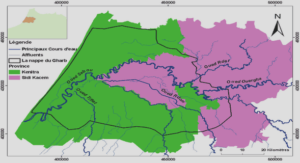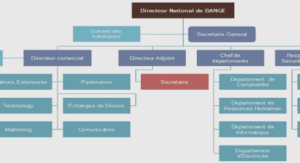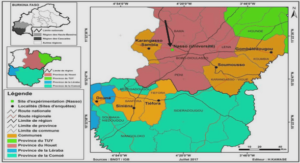Lesser Antilles Island arc
Martinique is located in the central part of the Lesser Antilles Island arc, which results from the westward subduction of the Atlantic plate under the Caribbean plate (Fig. 1a). Whereas in the southern part of the arc, volcanic activity occurred along a single SW-NE axis, the northern part, which experienced a westward jump of the volcanic front, is divided into two distinct branches (Fig. 1a, Fink, 1972). The inactive arc lies to the east (dashed line in Fig. 1a) where volcanic activity took place from the Eocene to the Oligocene (Bouysse et al., 1979; Westercamp, 1972; Germa et al., 2008). From Grenada to Saba, the islands that constitute the internal arc are called the Volcanic Caribbees (black line, Fig. 1a), where volcanism is currently active since the early Miocene (Bouysse et al., 1979; Westercamp, 1972). Due to its central position where the two northern arcs merge, Martinique is the Lesser Antilles Island where the most complete history of the arc can be found, from 20 Ma to present (Briden et al., 1979; Westercamp et al., 1989). 2.2. Martinique Island With an area of 1100 km2 , Martinique is the largest island of the arc. It lies at 14°N and 61°W, between Dominica and Saint Lucia islands (Fig. 1a). Volcanic activity has been almost continuous from the Oligocene to historic times, and eight volcanic units have been identified (Fig1b; (Andreieff et al., 1988; Grunevald, 1965; Westercamp, 1972; Westercamp et al., 1989; Westercamp et al., 1980)): (1) the Basal Complex and Saint Anne series (26 – 20 Ma, Germa et al., 2008), (2) the Vauclin-Pitault submarine chain (17 – 10 Ma), (3) the South western volcanism (8.5 – 6.5 Ma), (4) the Trois Ilets volcanism (3.5 – 0.6 Ma), (5) the Morne Jacob volcano (5.5 – 2.2 Ma), (6) the Carbet complex (2 – 0.9 Ma), (7) the Conil Complex (1.2 – 0.4 Ma) and (8) the Mount Pelée volcano. We describe below these last four Plio-Pleistocene complexes and associated ages previously available for the northern Martinique
Morne Jacob Volcano
The construction of the Morne Jacob shield Volcano, the largest volcanic edifice of the whole Lesser Antilles Island arc (> 350 km2 ), began about 5 Myr ago, with basaltic to andesitic hyaloclastites and subaerial lava flows emitted from ENE-WSW fractures (Westercamp et al., 1989). These authors identified a first building stage that occurred between 5.5 and 4.1 Ma (light blue in Fig. 2) followed by a second phase from 2.7 to 2.2 Ma (dark blue in Fig. 2) with massive lava flows reaching the Caribbean coast.
Carbet complex
The Carbet complex was constructed on the western flank of Morne Jacob volcano (Fig. 2). The building of an andesitic edifice (light brown in Fig. 2) has been estimated between 2 and 1 Ma ago based on the dating of pyroclastic flow deposits and few lava flows. This stage ended with the emplacement of lava domes then dated at about 1 Ma (Westercamp et al., 1989). This younger limit has been recently challenged by Samper et al. (2008) who found an age of 770 ± 11 ka (Table 1) for Piton Gelé, which is located at the northeastern limit of the complex, whereas an older age of 1.06 ± 0.10 Ma was previously inferred (Westercamp et al., 1989). A flank-collapse of about 30 – 40 km3 (Boudon et al., 2007) occurred between 1.86 ± 0.03 Ma and 341 ± 5 ka (Samper et al., 2008), yielding a horseshoeshaped structure opened to the west (white line, Fig. 2) and characterized by massive debrisavalanche deposits outcropping along the Caribbean coast, while, surprisingly, no associated such deposits have been recognized offshore (Boudon et al., 2007). The Pitons du Carbet s.s. are a group of seven voluminous lava domes, plus 5 isolated smaller ones, of andesitic composition, emplaced inside the horseshoe structure (dark brown, Fig. 2). Five of them are – CHAPITRE V – Chronologie éruptive de l’arc récent dans le compartiment nord de la Martinique (Article) 159 higher than 1 000 m: Piton Lacroix (1 196 m), Piton Boucher (1 070 m), Piton de l’Alma (1 105 m), Piton Dumauzé (1 109 m), and Morne Piquet (1 160 m). A mean emplacement age of 337 ± 5 ka (Table 1) has been obtained for three of these lava domes (Alma, Morne Piquet and Piton Man Roy; Samper et al., 2008).
Conil complex and Mount
Pelée Between 1 and 0.4 Ma, the Mount Conil complex (blue crosshatch, Fig. 2) was built in the northern end of the island. It is composed of andesitic breccias, lava domes and lava flows. The end of its activity corresponds to the beginning of the building of Mount Pelée Volcano (pink in Fig. 2, Westercamp et al., 1989). Because only sparse geochronological data are available for Mount Conil (Table 1), timing of its activity is not well known but seems to have occurred between: 1.20 ± 0.20 Ma (Andreieff et al., 1988) and 0.4 ± 0.2 Ma (Bellon et al., 1974). Three eruptive periods have been identified for the recent Mount Pelée within two main stages called the Paléo and Néo-Pelée. These stages consist of successions of construction and destruction periods (Le Friant et al., 2003). This volcano experienced three major flank collapse events (D1, D2, D3), respectively at 100, 25 and 9 ka (black lines, Fig. 2a), followed by the building of a new cone inside each horseshoe-shaped structure (Le Friant et al., 2003). Some U – Th ages (Table 1) have been obtained on lava domes that were affected by the flank collapse events, permitting the chronological reconstruction of the Mount Pelée history, and more than a hundred of 14C ages available allow a satisfactory understanding of the last 40 kyr of activity (Boudon et al., 2005). Twenty-eight magmatic eruptions occurred during the last 16 kyr, with ten plinian and eighteen dome-forming eruptions, plus an unknown number of phreatomagmatic and phreatic eruptions (Boudon et al., 2005). Since the European settlement, two phreatic eruptions occurred in 1792 and 1851, – CHAPITRE V – Chronologie éruptive de l’arc récent dans le compartiment nord de la Martinique (Article) 160 and two magmatic dome-forming eruptions in 1902 – 1904 and 1929 – 1932. The flanks of Mount Pelée are mainly composed of pyroclastic flow deposits related to three types of activity (St Vincent, Plinian and Pelean; Boudon et al., 2005). Ninety percent of its subaerial deposits are volcaniclastics, and minor lava domes and flows are only present near the summit (Aileron lava dome, Morne Macouba, and historic lava domes).
Materials and methods
Sampling technique
During March 2006 and April 2007, 55 fresh lava flows and domes were sampled in Northern Martinique within the Morne Jacob volcano (n = 33, circles in Fig. 2b), Carbet complex (n = 7, diamonds in Fig. 2b), Mount Conil complex (n = 10, squares in Fig. 2b) and Mount Pelée volcano (n = 5, squares in Fig. 2b). At each location, hand-size blocks were sampled for geochronological and geochemical studies. To constrain through time the evolution of each complex, we have chosen the most significant sites and located escarpments, quarries, road cuts, coastal cliffs and rivers after examination of DEM, topographic and geological maps. Indeed, due to the tropical climate, erosion and presence of dense vegetation, outcrops were limited to these specific locations. In a companion paper (Labanieh et al., 2008), major, trace elements and isotopic compositions, obtained on the same samples than those dated here, are presented in details






